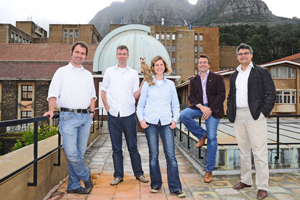UCT radio astronomy scores large chunk of MeerKAT observation time
08 November 2010 Gravitas: Dr Benne Holwerda, Prof Erwin de Block, Dr Sarah Blyth, Prof Patrick Woudt and Dr Kurt van der Heyden.
Gravitas: Dr Benne Holwerda, Prof Erwin de Block, Dr Sarah Blyth, Prof Patrick Woudt and Dr Kurt van der Heyden.
Four UCT Astrophysics, Cosmology and Gravity Research Centre (ACGC) Key Science proposals are among ten successful bids for the 43 000 hours of observing time allocated to radio astronomers from Africa and around the world on South Africa's MeerKAT telescope.
A precursor telescope to the Square Kilometre Array (SKA), which will be the largest radio telescope in the world (South Africa and Australia are both bidding to host this multi-billion-euro facility), the MeerKAT telescope consists of 64 13.5m diameter Gregorian offset dishes. A MeerKAT engineering test bed of seven dishes (KAT-7) is already complete on the potential SKA site near Carnarvon in the Northern Cape Province. This will contribute to the development of technology required for SKA.
Radio astronomy is the study of celestial objects that emit radio waves. These objects could be galaxies but could also be exploding stars. Radio telescopes like MeerKAT harness these faint signals, allowing astronomers to probe the 'Dark Ages' of the Universe, the time before the birth of the first stars or galaxies
The four UCT proposals, or Key Science projects, were among 21 involving more than 500 radio astronomers around the globe (including 59 astronomers from South Africa) following the invitation from the MeerKAT project issued in October last year. The other winning proposals were from Australia, the UK, India, Germany, and the Netherlands. Projects were reviewed and rated on the basis of their scientific merit, and technical and operational feasibility.
Each proposal has been awarded a substantial tranche of telescope time during the first five years of MeerKAT's operation (the telescope comes on stream in 2015). Together the UCT projects (led by ACGC scientists) will account for 40% of the observation time allocated.
Drs Sarah Blyth and Benne Holwerda, together with a colleague from the US, will lead the Deep HI Field project, an ultra-deep survey of neutral hydrogen gas in the early Universe. SARChI Chair in Radio Astronomy Professor Erwin de Blok's Mhongoose study will focus on deep observations of 30 nearby galaxies (25 times deeper than previous observations).The Mightee project, by Dr Kurt van der Heyden and Matt Jarvis will lead the International GigaHertz Tiered Extragalactic Explorations Survey. In their ThunderKAT project, Professor Patrick Woudt and Professor Rob Fender of the University of Southampton in the UK will lead the hunt for dynamic and explosive radio transients.
The coup underscores UCT's strength in radio astronomy. Last year, the National Research Foundation awarded R48 million to underpin the establishment at UCT of the Chair in Extragalactic Multi-Wavelength Astronomy in the ACGC.
"Two of the main strengths in the department are radio astronomy and the evolution of neutral hydrogen gas in the Universe," De Blok adds.
Many of the projects need 'radio-quiet' parts of the planet, areas without mobile phones, which De Blok, describes as "the enemy of radio astronomy". De Blok and PhD student Bradley Frank also played a role in designing the configuration of the MeerKAT telescope.
 This work is licensed under a Creative Commons Attribution-NoDerivatives 4.0 International License.
This work is licensed under a Creative Commons Attribution-NoDerivatives 4.0 International License.
Please view the republishing articles page for more information.










